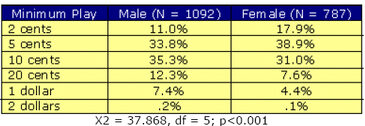Do men and women have different gambling behaviors? A recent WAGER, reported on a Brazilian study that found that treatment-seeking women started gambling significantly later in life than did treatment-seeking men, and that women progressed from intense gambling to problem gambling at a much faster rate. This week’s WAGER reports on a study by Hing and Breen (2001) that explored the slot machine playing tendencies of men and women.
Hing and Breen telephoned members of six gambling clubs in Sydney, Australia in November and December 1996. They contacted 16,642 households to achieve their goal of 3000 interviews. The interviews lasted approximately 20 minutes and addressed three topics: (1) frequency of participation in various types of gambling, (2) gaming machine playing behaviors including preferred types of machines, and time and money spent, and (3) the South Oaks Gambling Screen (Lesieur and Blume, 1987) to measure problem gambling. Of the total 3000 interviews, 2430 reported having gambled on at least one of the 13 gambling activities identified on the survey. Of the 2430 individuals, 1,879 (77%) reported playing slot machines at some time in their life. Men and women were not significantly different in the prevalence of pathological gambling (3.0% of women and 4.1% of men).
Hing and Breen hypothesized that female gamblers would employ a strategy that maximized the playing time per dollars spent. The authors expected that this strategy would predict a greater preference among women for lower denomination machines. The results of the study confirmed this expectation. The authors reported that regardless of pathology, more women than men played two-cent and five-cent machines and more men played 20 cent and higher machines.
Figure 1. Preferences by Minimum Play and Gender
The results of this study suggest that women seek to lengthen the time they gamble by playing lower denomination machines. Other study results support this finding. For example, female slot machine players were more likely than men to play the slot machines for more than one hour per session. However, the authors’ conclusion that female gamblers extended their playing time in an attempt to create community is a speculation by the authors that was not directly evaluated in the study. It’s also possible that the extended playing time was merely coincidental. Perhaps women in the study had less expendable income and had to play lower denomination machines by necessity, which inadvertently lengthened their gaming time. Similarly, it might be that females wanted to stay away from home more than their male counterparts and therefore sought an extended gambling experience. Each of these hypotheses requires more research.
Widening the research lens to include female-specific gambling behavior is essential to gain an improved understanding about gambling. Through a better understanding of the gambling of women in particular, we are likely to improve our understanding of gambling in general. It is also important to investigate the role that ethnicity, race, age, and other demographic factors play in shaping gambling behavior. As research progresses, it is of import that investigations are inclusive of all the factors that interact to impact gambling behavior. Hing and Breen have provided important insight into gender-related issues that can influence gambling patterns.
References
Hing, Nerilee and Breen, Helen, (2001). Profiling Lady Luck: An Empirical Study of Gambling and Problem Gambling Amongst Female Club Members, Journal of Gambling Studies, 17(1), 47-69.
Lesieur, H. and S.B. Blume, (1987). The South Oaks Gambling Screen (SOGS): A New Instrument for the Identification of Pathological Gamblers, American Journal of Psychiatry, 144, 1184-1188.





